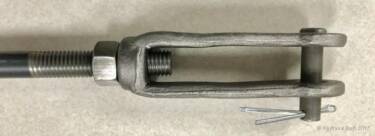How do you lock a tie rod assembly in place?
 The easiest way to lock a tie rod assembly in place is by including an extra nut that can be run up against either the clevis or the turnbuckle. Once the nut has been jammed in place the assembly will be unable to move. These pictures show that the nut has to be placed on the outside of the clevis or turnbuckle, and you cannot assemble the nut inside either piece of hardware since it will not fit. One nut is typically sufficient to freeze the tie rod in place since keeping one component from moving will keep the entire assembly in place. If an additional nut is required it would need to be left handed which is typically only available in plain finish. If the assembly is galvanized, then a left handed nut would most likely need to be manufactured to order.
The easiest way to lock a tie rod assembly in place is by including an extra nut that can be run up against either the clevis or the turnbuckle. Once the nut has been jammed in place the assembly will be unable to move. These pictures show that the nut has to be placed on the outside of the clevis or turnbuckle, and you cannot assemble the nut inside either piece of hardware since it will not fit. One nut is typically sufficient to freeze the tie rod in place since keeping one component from moving will keep the entire assembly in place. If an additional nut is required it would need to be left handed which is typically only available in plain finish. If the assembly is galvanized, then a left handed nut would most likely need to be manufactured to order.

If your plans specify a “locking nut” to be used for this application, this term can be somewhat ambiguous. Our interpretation of a “locking nut” when used in conjunction with a tie rod assembly refers to the nut’s application instead of the style of nut. In other words, a “regular” nut would be functioning to lock the assembly in place rather than using a self-locking nut such as an ANCO locknut, a prevailing torque locknut, or nylon insert locknut. The idea of a self-locking nut is to not be able to back the nut up once you assemble it. In order to lock a tie rod assembly in place, you will need to run the nut past where you want it, tighten the tie rod assembly, and then back the nut up against the clevis or turnbuckle. For this reason, the “locking nut” specified on the plans should be a regular nut that functions as a locking device. Clarification from the Engineer of Record may be required.

